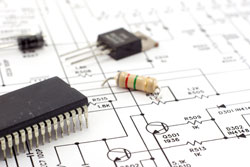Ultra low power integrated circuits
A field effect transistor is a semiconductor device through which the current is carried by minority carriers only, that is, it is a unipolar device. This current flows through a narrow channel, from the source to the drain. The voltage applied at the gate controls the charge in the channel and consequently the transistor's conductivity. In the course of the ATHIS project, it was shown that ultra low power circuits can be built with multi-threshold MOSFETs and ultra low power reverse biased diodes. The ultra low power (ULP) diodes are also built by two complementary MOSFETs in such a way that the diode reverse current is reduced by 3 to 4 orders of magnitude when compared to standard devices. It is in this region of ultra-low leakage and negative impedance characteristic in reverse mode that the new ULP device is currently the more scientifically and industrially interesting. The ATHIS project developed these ULP circuits by biasing the complementary n-MOS and p-MOS transistors in static operation at a gate-to-source voltage lower than zero. This way, the leakage current was reduced by orders of magnitude offering a much lower static power dissipation. On the basis of the ULP diode principle, a memory cell and a voltage doubler have also been developed and experimentally tested in ATHIS. Their ability to function well at high temperatures (that is, up to 200 - 300°C) must be especially noted. These innovative circuits have already been patented and their immediate widespread application in digital and analog circuits is expected, notably for portable as well as harsh environment products. Further developments are under way concerning RFID tags and sensors interfaces, for example, for the biomedical field.



